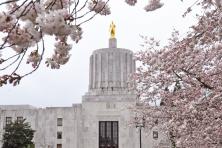WHAT’S NEXT FOR CLIMATE
The most recent Intergovernmental Panel on Climate Change report is clear: we must take immediate, bold action to address the climate crisis and to avert mounting catastrophic and deadly impacts. The Washington State Legislature has made important progress, but there is more the legislature must do to take urgent action to reduce our carbon pollution and meet our statutory climate goals. Our health and the health of our state cannot wait, as we are already seeing climate impacts, including hotter temperatures, more frequent and fiercer wildfires, and flooding. The time is now for the Legislature to accelerate big solutions to the climate crisis, since the sooner we act, the faster we’ll benefit.
TRANSPORTATION
We all want clean, affordable, accessible, safe and efficient ways to get around. Our transportation system is a crucial part of everyone’s life, enabling or restricting us from accessing essential services, job opportunities, or helping break the cycle of poverty. We all rely on our transportation system, yet transportation fuels are responsible for nearly half of our climate and harmful air pollution in Washington. Cleaning up transportation pollution will help cut climate pollution and improve public health while addressing environmental racism in our transportation system. Part of cutting transportation pollution is ensuring that housing is built near jobs and services so people are easily able to go about their daily activities without needing to rely on a personal vehicle.
BUILDINGS
Heating and powering our homes and businesses generates a substantial amount of our climate-changing pollution, and emissions from buildings are growing at a faster rate than any source of carbon pollution in Washington State. If our homes and buildings were carbon-free and energy efficient, we would significantly reduce our climate pollution, drastically cut energy costs for owners and renters, and improve air quality where we live and work. In addition, where and how we build matters and planning should be consistent with our state’s climate goals.
CROSS SECTOR
We can have a thriving, equitable Northwest, powered by clean energy and we can lead and inspire the transition to sustainable prosperity across the nation and beyond. The fossil fuel industry’s resistance to innovation and progress toward a clean energy future means that we need a broad and committed movement to accelerate clean energy solutions to the climate crisis. With Washington’s natural resources, historic clean energy achievements, technology leadership, and emphasis on sustainable prosperity make our region a natural leader in the transition to a clean energy future.
CLEAN TRANSPORTATION & LAND USE
Research from Climate Solutions shows the best way to decarbonize transportation requires both electrification of nearly all vehicles on the road and reducing the need for personal vehicles through transit expansion, efficient land use policy, safe bicycle and pedestrian networks, and more. If we achieve this clean transportation future, not only will we mitigate dangerous climate change, but personal transportation costs in the Pacific Northwest will fall by an average of over $4,000 per year, annual healthcare costs across the region will be cut by as much as $626 million by 2050, and we’ll avoid hundreds of crash fatalities every year. The climate agenda for the 2022 session will set Washington on a path to achieving this future by building on the success of the Clean Fuel Standard.
TRANSPORTATION FUNDING & INVESTMENTS
Washington State must adequately fund clean transportation options, including transit, but is short on funding. Revenue from the Climate Commitment Act will support transportation electrification, transit, and other clean options--but this still doesn’t meet the level of investment we need. The legislature should pursue new sources of transportation revenue that are progressive, climate-forward, and flexible in how they can be spent. Investments should prioritize multimodal solutions, heavy-duty vehicle electrification, and electrification options for low-income communities. Investments that are 18th amendment-restricted should prioritize removing barriers to fish passage and preservation and maintenance, rather than prioritizing new road construction.
Climate Solutions strongly supports revenue options such as the Air Quality Surcharge, a luxury transportation tax, a well-designed Road Usage Charge, and expanding revenue collection options for local governments. All such sources should be designed to minimize impacts on low- income populations, and maximize benefits for communities burdened by pollution and the workers who will build our clean energy future.
Air Quality Surcharge
An air quality surcharge would be a one-time charge on the sale of new vehicles and on the remaining life of a vehicle being retitled in Washington for the first time. The charge would vary based on a vehicle’s estimated lifetime greenhouse gas pollution, thereby incentivizing cleaner vehicle purchases in addition to providing much-needed multimodal funding.
Why an Air Quality Surcharge?
- Progressive and equitable revenue: Since it only applies to new vehicle purchases and retitling, an Air Quality Surcharge would be a progressive source of revenue that would only impact a small number of Washingtonians who are in the top fifth of income earners on average.
- Cleaner vehicles: An Air Quality Surcharge encourages cleaner vehicle purchases and spurs electric vehicle adoption.
- Flexibility: Policymakers can design the surcharge to ensure relatively stable revenue.
- Fairness: Because the Air Quality Surcharge is based on average vehicle lifetimes, it does not lead to higher costs for those who need to drive more.
GROWTH MANAGEMENT ACT
Even though climate change, housing affordability, and issues of environmental justice are having profound impacts in Washington, currently our state’s Growth Management Act (GMA) fails to address climate change. The GMA should be updated to reflect these realities and ensure our long-range planning leads to reduced climate pollution, more resilient communities, and adequate affordable housing. This must happen soon, in the 2022 legislative session, before cities and counties embark on updating their next comprehensive plan, to ensure those plans include considerations for climate change, greenhouse gas emissions reductions, and consistency with the state energy strategy and climate goals.
CLEAN BUILDINGS
Buildings are the fastest-growing source of emissions in Washington, which is largely attributable to the use of fossil gas for space and water heating and cooking. Gas combustion also increases indoor and outdoor air pollution, making buildings the primary source of pollution-related deaths in the state, and puts residents at risk of gas leaks and explosions.
Washington needs policies to move towards 100% clean, all-electric buildings that will keep residents safe and healthy.
BENEFICIAL ELECTRIFICATION
A home heating electrification plan would clarify that public utilities have the authority to develop and demonstrate a business case for electrification incentives. Electrification programs would be beneficial to both the utility and provide incentives to utility customers to invest in efficient, clean electric appliances, so it’s a win-win.
Why home heating electrification?
- Health: Combusting fossil fuels in homes and buildings is not only a significant contributor to climate change, but also poses significant health risks from indoor and outdoor air pollution. In Washington, pollution from using gas in homes and buildings is more than twice as much as the pollution from the state’s gas-fired power plants! Outdoor air pollution alone from burning fossil fuels in buildings led to an estimated 559 early deaths and $6.266 billion in health impact costs in Washington in 2017.
- Incentives and customer choice: Currently, a customer that relies on a nonelectric heating source – such as wood stoves, heating oil, or a gas furnace – is ineligible to receive incentives from their public electric utility to upgrade to electric appliances. However, their neighbor that currently relies on electricity to heat their home can receive incentives from their utility to upgrade their furnace when the time is right.
- Equity: With the passage of the Clean Energy Transformation Act, all low-income customers are able to receive public assistance to pay their electric bills, so being able to make the switch with utility assistance is crucial for equitable outcomes.
- Net system benefits: Utility research from Seattle City Light, Tacoma Public Utilities, and others indicates that new electric load isn’t just good for the individual customer, it’s good for all customers and can prevent rate increases.
CLEAN ECONOMY
CROSS SECTOR
With the economics of climate solutions improving rapidly and the business world making commitments that will further drive down costs, more people have access to clean energy every day. Beyond transportation and buildings, Washington’s climate policy must also include a focus on standards, investment, and justice in order to address the challenges before us at speed and scale.
BUY CLEAN, BUY FAIR
Buy Clean policies, such as the policy passed in California in 2017, mandate that emissions from certain materials be documented and considered when contracting for state-funded infrastructure projects. Adding a Buy Fair element requires contractors and subcontractors to report on domestic labor law compliance in the countries where they produce goods and services, incentivizing clean and fair manufacturing. In 2022, advocates will prioritize a bill that requires disclosure of embodied carbon (carbon associated with a product’s manufacture) and labor practices to help the state understand its procurement practices, and consider procurement requirements in future sessions.
Why Buy Clean, Buy Fair?
- Cleaner products: Buy Clean, Buy Fair would harness the state’s purchasing power to cut hidden, embodied carbon. Right now, Washington does not consider greenhouse gas emissions when purchasing materials for state infrastructure projects, allowing dirty manufacturers to be treated the same as those who have invested in emissions reductions technology.
- Protecting workers: Buy Clean, Buy Fair encourages contractors to produce and purchase goods from responsible manufacturers who have good labor practices.
- Leveling the playing field: California’s Buy Clean policy helped even the playing field for local manufacturers and their workers – many of which are union-represented.
IMPROVE CLEAN ENERGY SITING
Washington’s environmental protection laws have afforded us clean air and water and a healthful environment, but they are not up to the challenge of the clean industrial revolution we need. To successfully achieve the carbon reductions required by Washington’s clean energy laws, we need to replace our expansive fossil fuel infrastructure--oil refineries, natural gas power plants, and more--with new clean replacements: clean manufacturing, green hydrogen production, renewable energy generation, new transmission capacity, biofuel refining and more. It’s time to improve our siting laws to permit and build new clean energy production and manufacturing to enable Washington to lead the global economy into a clean future. This includes clarity for project proponents around the state’s expectations, certainty and predictability around review timeline, and more--we need to uphold and clarify Washington’s environmental protections and welcome new job-creating development.
FINISHING THE JOB ON THE CLIMATE COMMITMENT ACT
2021’s passage of the landmark Climate Commitment Act (CCA) will herald a new more sustainable economy for our state, but a number of topics remain unfinished that need to be addressed in 2022.
- Restore tribal consultation for CCA funded projects: Governor Inslee vetoed provisions in the CCA that would have required tribal consent for projects funded with carbon dollars. It’s imperative to restore similar provisions, recognizing the historic role of tribal governments in stewarding our natural resources and their deep knowledge in this space. We will follow the lead of tribal nations in addressing this essential component of the law.
- EITE provisions: Emissions intensive and trade exposed businesses deserve special treatment under carbon pricing to prevent leakage of emissions and jobs out of state. CCA’s current provisions require the Legislature to lay out a long term trajectory and treatment for these entities.
- Landfills: landfill emissions are covered under CCA beginning in 2031 unless a separate program is developed to address the 2.7 million tons of climate pollution they’re annually responsible for. Developing a program to reduce these emissions in productive ways will benefit everyone.
ORGANICS MANAGEMENT TO REDUCE METHANE AND COMBAT CLIMATE CHANGE
Sets a statewide target for diversion of organic material from the landfill/incinerator stream and a separate target for edible food diversion to food rescue groups. The goal is to reduce methane emissions, a potent greenhouse gas with more than 80x the warming impact of carbon dioxide, from landfills and to expand universal access to and capacity for managing organic material in Washington, including compost, anaerobic digestion and other technologies. Legislation will also reclaim usable food from the waste stream and help provide it to those most in need. Ecology’s 2020-2021 Washington Statewide Waste Characterization Study found that in 2020, 22.8% by weight (1.2 million tons) of the municipal solid waste disposed load is organic material and 13.5% (0.7 million tons) is wood debris. 8.5% of the total load is edible food. Beneficial uses of composted/processed organic material include soil carbon sequestration. Other climate beneficial uses result from widespread utilization of organics in landscapes, restorations, agriculture, and range and forest lands. A facilitated stakeholder process is ongoing to develop policy for Washington, based on a starting point of CA SB1383, which passed in 2016.





